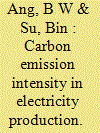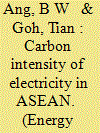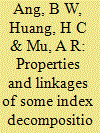| Srl | Item |
| 1 |
ID:
150669


|
|
|
|
|
| Summary/Abstract |
We study changes in the aggregate carbon intensity (ACI) for electricity at the global and country levels. The ACI is defined as the energy-related CO2 emissions in electricity production divided by the electricity produced. It is a performance indicator since a decrease in its value is a desirable outcome from the environmental and climate change viewpoints. From 1990 to 2013, the ACI computed at the global level decreased only marginally. However, fairly substantial decreases were observed in many countries. This apparent anomaly arises from a geographical shift in global electricity production with countries having a high ACI increasingly taking up a larger electricity production share. It is found that globally and in most major electricity producing countries, reduction in their ACI was due mainly to improvements in the thermal efficiency of electricity generation rather than to fuel switching. Estimates of the above-mentioned effects are made using LMDI decomposition analysis. Our study reveals several challenges in reducing global CO2 emissions from the electricity production sector although technically the reduction potential for the sector is known to be great.
|
|
|
|
|
|
|
|
|
|
|
|
|
|
|
|
| 2 |
ID:
149885


|
|
|
|
|
| Summary/Abstract |
The Association of Southeast Asian Nations (ASEAN), with its ten member countries, has a total population exceeding 600 million. Its energy-related CO2 emissions have been growing and in 2013 amounted to 3.6% of total global emissions. About 40% of ASEAN's energy-related CO2 emissions are currently attributable to electricity production. In view of this high share, we study the CO2 emissions of ASEAN's electricity production sector with a focus on the aggregate emission intensity (ACI) given by the level of CO2 emissions for each unit of electricity produced. Drivers of ACI are analysed for individual countries and spatial analysis is conducted by comparing factors contributing to differences between the ACIs of individual countries and that of the ASEAN average. Arising from these analyses and in light of the current developments, it is concluded that drastic actions need to be taken both at the national and regional levels in order to reduce growth in the region's electricity-related CO2 emissions. Two key policy issues, namely overcoming national circumstances to improve electricity generation mix and improving power generation efficiency, are further discussed.
|
|
|
|
|
|
|
|
|
|
|
|
|
|
|
|
| 3 |
ID:
121268


|
|
|
|
|
| Publication |
2013.
|
| Summary/Abstract |
Energy-related CO2 emissions embodied in international trade have been widely studied by researchers using the environmental input-output framework. In the literature two different approaches to deal with emissions embodied in a country's imports can be found. One of the approaches is based on the assumption of competitive imports while the other is based on the assumption of non-competitive imports. We show that the implications of the results obtained using different imports assumptions are not the same. The approach using the competitive imports assumption gives estimates larger than those obtained using the non-competitive import assumption. The differences between the two embodiment estimates come from the transition of embodied emissions in China's imports for intermediate consumption to those in China's exports. This explains why relatively high estimates of CO2 emissions embodied in China's exports are reported in several recent studies appearing in Energy Policy.
|
|
|
|
|
|
|
|
|
|
|
|
|
|
|
|
| 4 |
ID:
104911


|
|
|
|
|
| Publication |
2011.
|
| Summary/Abstract |
We present five performance indicators for electricity generation for 129 countries using the 2005 data. These indicators, measured at the national level, are the aggregate CO2 intensity of electricity production, the efficiencies of coal, oil and gas generation and the share of electricity produced from non-fossil fuels. We conduct a study on the potential for reducing global energy-related CO2 emissions from electricity production through simple benchmarking. This is performed based on the last four performance indicators and the construction of a cumulative curve for each of these indicators. It is found that global CO2 emissions from electricity production would be reduced by 19% if all these indicators are benchmarked at the 50th percentile. Not surprisingly, the emission reduction potential measured in absolute terms is the highest for large countries such as China, India, Russia and the United States. When the potential is expressed as a percentage of a country's own emissions, few of these countries appear in the top-five list.
|
|
|
|
|
|
|
|
|
|
|
|
|
|
|
|
| 5 |
ID:
092775


|
|
|
|
|
| Publication |
2009.
|
| Summary/Abstract |
We study the properties and linkages of some popular index decomposition analysis (IDA) methods in energy and carbon emission analyses. Specifically, we introduce a simple relationship between the arithmetic mean Divisia index (AMDI) method and the logarithmic mean Divisia index method I (LMDI I), and show that such a relationship can be extended to cover most IDA methods linked to the Divisia index. We also formalize the relationship between the Laspeyres index method and the Shapley value in the IDA context. Similarly, such a relationship can be extended to cover other IDA methods linked to the Laspeyres index through defining the characteristic function in the Shapley value. It is found that these properties and linkages apply to decomposition of changes conducted additively. Similar properties and linkages cannot be established in the multiplicative case. The implications of the findings on IDA studies are discussed.
|
|
|
|
|
|
|
|
|
|
|
|
|
|
|
|